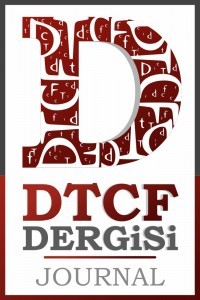FARKLI GERÇEKLİKLERİ DİLE GETİRMEK: MIDNIGHT'S CHILDREN'DA ÇOK SESLİLİK VE BÜYÜLÜ GERÇEKÇİLİK
Salman Rushdie'nin Geceyarısı Çocukları 1981 başlıklı romanında anlatıcı kendi hayat öyküsünü Hindistan tarihindeki önemli olaylara atıarda bulunup bu olayları anılarıyla yorumlayarak anlatır. Bu makalede romanda farklı gerçeklikleri yansıtma ve baskıcı güçlerin gücünü azaltmada çok sesliliğin ve büyülü gerçekçiliğin rolü incelenecektir. Romanda, Hindistan'da çok kültürlülüğün totaliter devlet tarafından tehdit edilişi anlatılmaktadır. Bu bağlamda anlatı büyülü gerçekçilik ve çok seslilik gibi yöntemlerle baskıcı yönetimin temsil ettiğinden farklı olan gerçeklikler sunmakta ve gerçeğin bireyin algısına göre değişiklik gösterebileceğini örneklemektedir. Eserde büyülü gerçekçilik öğeleri sayesinde çok seslilik daha geniş bir boyut kazanmıştır. Bu çalışma, büyülü gerçekçilik ve çok seslilik aracılığıyla Geceyarısı Çocukları'nın bir realizm eleştirisi sunduğunu; kimlik, ulus gibi kavramların değişmez olduğu düşüncesini ve resmi tarih anlatılarına güveni zayıattığını öne sürmektedir. Romanda çok kültürlü Hint toplumunun farklı bakış açıları yansıtılarak gerçeklik kavramının değişkenliği gösterilmekte ve baskıcı güçlerin dayattığı gerçekliğe bir alternatif sunulmaktadır.
Anahtar Kelimeler:
Çok Seslilik, Büyülü Gerçekçilik, Otorite, Tarih, Çeşitlilik
GIVING VOICE TO MULTIPLE REALITIES: POLYPHONY AND MAGIC REALISM IN MIDNIGHT'S CHILDREN
Salman Rushdie's Midnight's Children 1981 presents the autobiographical account of its unreliable narrator that forms a parallel to the history of India. To give an account of his past, the narrator reimagines historical events with a combination of his memories and recorded facts. This paper will discuss the role of polyphony and magic realism in establishing various realities and in undermining the conceptions of the totalising power founded on monologic view of the world. In the novel, cultural diversity of the Indian subcontinent is threatened by the totalising power of the state. Through the magical elements and the polyphonic narrative, which refects the consciousness of the others, the novel presents subjective versions of reality suggesting that reality is a matter of perception. Thus it takes polyphony one step further by the use of magical elements in giving voice to various possibilities. In this study it is argued that through its polyphonic narrative and magical realist elements, Midnight's Children not only undermines ofcial accounts of history and essentialist conceptions of identity and nation but also provides a critique of realism. By encompassing cultural diversity of the multicultural Indian community, the novel demonstrates the multiplicity of reality and undermines systems of authority replacing the totalising version of reality with a multitude of perspectives.
Keywords:
Polyphony, Magic Realism, Authority, History, Diversity,
___
- Bakhtin, Mikhail M. Problems of Dostoevsky’s Poetics. Ed. Caryl Emerson. Minneapolis: University of Minnesota Press, 1984.
- ---. Speech Genres and Other Late Essays. Eds. Michael Holquist and Caryl Emerson. Austin: Texas UP, 1986.
- ---. The Dialogic Imagination: Four Essays. Ed. Michael Holquist. Austin: Texas UP, 2008.
- Fenwick, Mac. “Crossing the Figurative Gap: Metaphor and Metonymy in Midnight’s Children.” Journal of Commonwealth Literature 39.3 (2004): 45-68.
- Fletcher, M. D., ed. “Introduction.” Reading Rushdie: Perspectives on the Fiction of Salman Rushdie. Amsterdam: Rodopi, 1994. 1-22.
- Ghosh, Bishnupriya. “An Invitation to Indian Postmodernity: Rushdie’s English Vernacular as Situated Cultural Hybridity.” Critical Essays on Salman Rushdie. Ed. M. Keith Booker. New York: G.K. Hall &Co., 1999. 129-153.
- Gorra, Michael. “’The Angrezi in which I am forced to write:’ On the Language of Midnight’s Children.” Critical Essays on Salman Rushdie. Ed. M. Keith Booker. New York: G.K. Hall &Co., 1999. 188-204.
- Hogan, Patrick Colm. “Midnight’s Children: Kashmir and the Politics of Identity.” Twentieth Century Literature 47 (2001): 510-544.
- Holquist, Michael. Dialogism: Bakhtin and His World. New York: Routledge, 1990.
- Kuchta, Todd M. “Allegorising the Emergency: Rushdie’s Midnight’s Children and Benjamin’s Theory of Allegory.” Critical Essays on Salman Rushdie. Ed. M.
- Keith Booker. New York: G.K. Hall &Co., 1999. 205-224.
- Leal, Luis. “Magical Realism in Spanish America.” Magical Realism: Theory, History, Community. Eds. Lois Parkinson Zamora and Wendy B. Faris. Durham, N.C.: Duke UP, 1995.
- Metcalf, Barbara D. A Concise History of Modern India. New York: Cambridge UP, 2006.
- Reder, Michael, ed. Conversations with Salman Rushdie. Mississipi: Missisipi UP, 2000.
- ---. “Rewriting History and Identity: The Reinvention of Myth, Epic, and Allegory in Salman Rushdie’s Midnight’s Children.” Critical Essays on Salman Rushdie. Ed. Keith Booker. New York: G. K. Hall & Co, 1999. 225-249.
- Rege, Josna E. “Victim into Protagonist? Midnight’s Children and the Post-Rushdie National Narratives of the Eighties” Critical Essays on Salman Rushdie. Ed. M. Keith Booker. New York: G.K. Hall &Co., 1999. 250-282.
- Rogers, Bruce Holland. “What is Magical Realism, Really?” Speculations. Spring (2002). Web. 18 October 2009.
- Rushdie, Salman. Imaginary Homelands Essays and Criticism 1981-1991. London: Vintage, 2010.
- ---. Midnight’s Children. New York: Penguin, 1991.
- Schürer, Norbert. Salman Rushdie’s Midnight’s Children: A Reader’s Guide. London: Contiuum, 2004.
- Swann, Joseph. “East is East and West is West”? Salman Rushdie’s Midnight's Children as an Indian Novel.” World Literature Written in English 26.2 (1986): 353-362.
- Wilson, Keith. “Midnight’s Children and the Reader Responsibility.” Reading Rushdie: Perspectives on the Fiction of Salman Rushdie. Ed. M. D. Fletcher. Amsterdam: Rodopi, 1994. 55-68.
- Yayın Aralığı: Yılda 2 Sayı
- Başlangıç: 1942
- Yayıncı: Ankara Üniversitesi
Sayıdaki Diğer Makaleler
UWE TIMM'İN “KARDEŞİMİN ÖRNEĞİNDE” Am Bespiel meines Bruders BELLEK YANSIMALARI
Macar Halk Şarkılarında 1848-1849 Macar İhtilâli ve Lajos Kossuth
Zabşali, Tukriş ve Loso Bölgelerini İçeren Alanda İlam Dönemine Ait Toponimi Çalışması İçin Öneri
Ali AARAB, Mahammad Esmaeil Esmaeılı JELODAR, Alireza KHOSROWZADEH
ONDALIK KESİRLERİN OSMANLI MUHASEBE MATEMATİĞİ ESERLERİNDEKİ YERİ 15-17. YÜZYIL
Peri Anne Prensese Aşık: Emma Donoghue'nun Yeniden Yazılmış Masallarındaki Lezbiyen Arzu
“KÜLTÜREL YOKSUNLUK” VE GEÇMİŞE TAKILMIŞ BİR İRLANDALI
FARKLI GERÇEKLİKLERİ DİLE GETİRMEK: MIDNIGHT'S CHILDREN'DA ÇOK SESLİLİK VE BÜYÜLÜ GERÇEKÇİLİK
